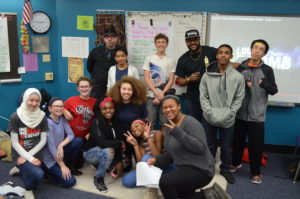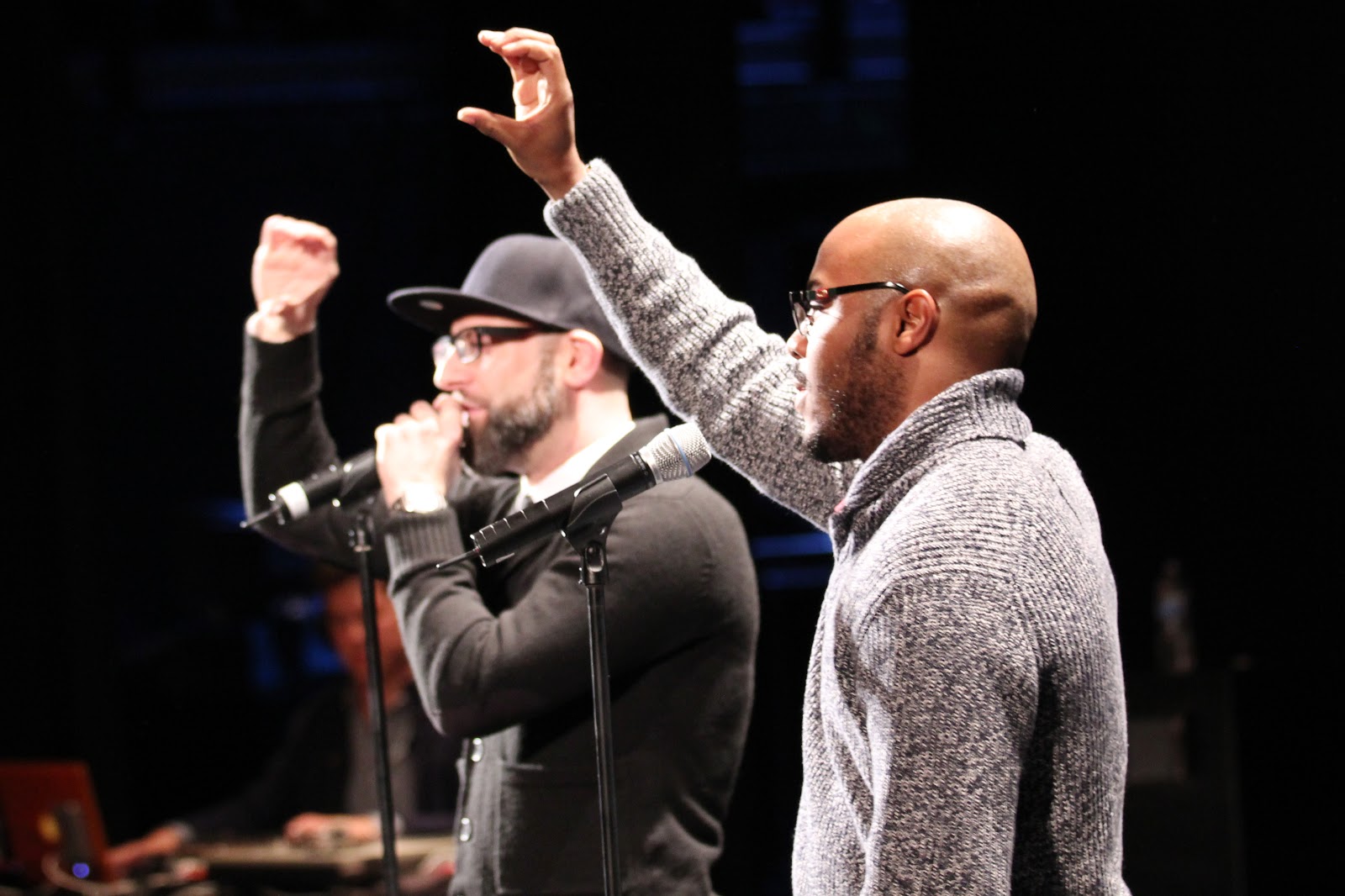Feature Blog Post by Program Director, Anna Ojascastro Guzon
Sit down, hol’ up… be humble. – Kendrick Lamar
Almost 10 years ago, directors Greg Jakobs and Jon Siskel created the award-winning film about Louder than a Bomb: A Chicago Youth Poetry Festival. The documentary features co-founder Kevin Coval and students participating in the competition, including Nate Marshall. From the South Side of Chicago, Nate started writing around the age of 12. And like many of the kids who participate in Louder than a Bomb (LTAB), he grew up in a place where survival wasn’t taken for granted. Seeing the documentary ten years ago, one might wonder how the “documentary kids” turned out. They found poetry, mentors, a community of like-minded kids, and a safe place in which one could express oneself, in front of hundreds of people. And then what?
Today, Nate, now in his late-twenties, is an internationally acclaimed writer, educator, and community organizer for the 2016 MacArthur Award-winning organization Young Chicago Authors (YCA). Kevin is the artistic director of YCA and has written or edited more than ten books. His book of poetry, The People’s History of Chicago, came out just weeks ago from Haymarket Books, garnering immediate praise from the community and critics, as well as landing poetry a rare spot on mainstream television, with a recent appearance on Trevor Noah’s The Daily Show.
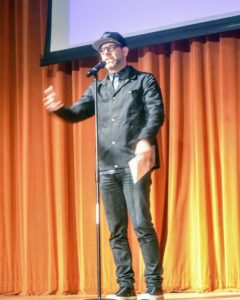
For National Poetry Month, YourWords STL hosted the duo on a tour of five different schools plus a performance at The Stage at KDHX. At 8:30 a.m., Nate and Kevin walked into the New City School theater, Kaldi’s coffee cups in hand, each donning a baseball cap, jeans, and black shirts, coats and shoes. They arrived in St. Louis after midnight yet they were both smiling beneath the straight bills of their caps, Kevin, with thick-rimmed glasses, and Nate, with an untrimmed beard.
I hugged them as if they were my childhood friends and thanked them for coming. Kevin looked me directly in the eyes and asked, “Are you okay?”
“Wow, you’re perceptive,” I said, impressed by his candor, considering we had only exchanged about ten words and met for the first time just two weeks prior.
In fact, I was nervous about speaking in front of a large crowd. Coherent, yet barely audible, I read my intro to the Louder than a Bomb poets. When I sat back down, Kevin, the same age as me yet consistently the encouraging teacher, commented, “See, you were great. Now you can relax, right?”
When Nate and Kevin took the stage, they read poetry, some memorized, some fresh from a notebook. They spoke with agility and easily connected with their audience. They blended hip-hop with classical forms, resulting in kids yelling and over-the-head clapping for that sestina or aubade that Nate just spit. And the children didn’t see Kevin as some middle-aged guy reciting poems. He has the ability to connect with people of all classes, cultures, and ages, through not just his delivery but also the intention of his words.
& sometimes
you’d see a kid whisper to himself
in the corner of a bus seat & you
asked if he rhymed & traded a poem
a verse like a fur pelt/ trapping.
some good or gold. this sustenance.
-Kevin Coval
from the poem, moleman beat tapes
Their poems had strata of meaning, yet were accessible at the same time. Their voices created variations in rhythm, tempo, dynamics, phrasing, and pitch, without a note actually being sung. Over twelve hours and four performances later, they still brought the crowd to tears, laughter, and a standing ovation.
One can compare both Coval and Marshall to grammy-winning hip-hop artists. They address real life experiences, using the city as inspiration. With references to particular people and places, they let the world in on Harold’s fried chicken, Clark Street, their mothers, and all else that resides between one’s heartbeats. And when children jump to their feet, shouting, and nodding, you know audience members can see themselves in Nate and Kevin’s poetry.
… a small weapon sits behind the counter hidden by the cigarettes
& candy small enough to steal. when the liquor store
is locked up the rolling metals make the window
a pastoral, part of our natural habitat. behold the liquor store:
-Nate Marshall
from the poem, Fame Food and Liquor
But unlike some famous rappers, they lack bravado. Neither of the artists is on stage to feed their egos; they have an obvious love for humanity. At every venue, whether they were with 15 people or 500, Nate and Kevin asked, “But we want to hear what you guys think. What do you guys like? Where do ya’ll like to eat around here? Who do ya’ll like to listen to?” In other words, Coval and Marshall can spit rhymes but they’re also educators, community organizers, scholars, and writers.
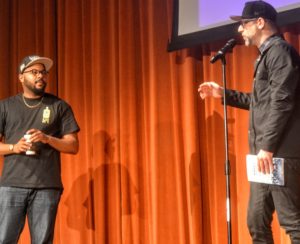
Our guests started their tour with New City School and Crossroads College Preparatory School, where they could interact with creative children, representing dozens of zip codes, from Ballwin to O’Fallon, Illinois. In 2016, Young Chicago Authors won a MacArthur Award for their work with thousands of Chicago youth. By teaching that writing and performing poetry can be a fun and even an exhilarating experience, YCA has deleted margins. If one isn’t a “good” student, if one is disabled, deaf, in prison, a refugee, and especially, if one doesn’t fit in anywhere else, YCA extends its arms. Disrespect is the only behavior that isn’t tolerated. While attending the LTAB National Symposium, one hears crowds repeating rules of the competition like a spoken-word pledge, “NO racist, sexist, homophobic, gender-biased, ableist, ageist, anti-religious, transphobic language allowed.” New City’s pre-k through 6th-grade version is simply, “NO put-downs.” Another version, printed on ubiquitous pins, is even more succinct: RESPECT.
Less than a block from New City School is the intersection of Delmar Boulevard and Kingshighway Road. South of Delmar are the faithfully maintained, all brick, three-story homes with swimming pools. To the north, just across the street, begins the land that was once some of the first land available to former slaves for ownership. In 1916, an ordinance was created stating that white people could not move into the neighborhoods that were mostly black and vice versa. The ordinance only lasted a year, but some white St. Louisians made agreements not to sell their homes to black people. 100 years later, the block just north of Delmar and Kingshighway has a poverty rate of almost 60 percent. One block south of the intersection, the poverty rate is 9 percent.
Having ridden past the courtly homes of Lindell Boulevard, Nate noted the sharp change in our surroundings, “It looks like Detroit.” One of our board members followed us on our tour. As a native of Seattle, still settling into St. Louis, she wanted to educate herself. “It’s like an alternate reality,” she commented. If you haven’t crossed the Delmar Divide, either heading north or south, I recommend you experience crossing into “the other dimension,” which one can’t help but sense, the first time one crosses the boulevard.
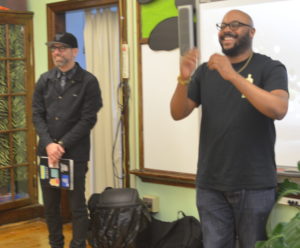
In the neighborhood of Penrose, in far Northeast City, is St. Louis Catholic Academy (SLCA), an amalgamation of small Catholic schools in the area. Their population is 100 percent black and every child has a parent or guardian who chose to pay what they could in order to send their child to a small Catholic school, where they personally drop off and pick up their children. The lawns that line the streets have signs that say, “We must stop killing each other.” And the closest major intersection, Natural Bridge and Kingshighway, is a tract that has one of the highest murder rates per capita, in the United States.
We visited the sixth-grade class, with a total of 13 children. While they are usually an affable group, at that moment, the kids were under the strict command of a substitute and appeared sullen.
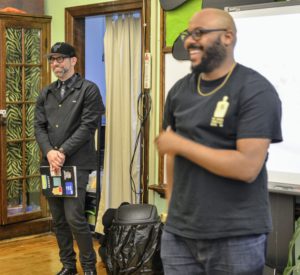
When our internationally renowned poets asked if the students wanted to write, several replied with an honest, “NOOO!” While Kanye might walk out of the building under such circumstances, Kevin and Nate rolled with it, without an eye-blink. The children wanted to read their newly written poems, then Nate and Kevin read and performed, which had the kids shouting in recognition of themselves in the poets’ stories. As if seeing a professional handle a ball or musical instrument in a way that only comes from surpassing the 10,000-hour rule, their poems instantly charged the classroom. Nate kept most of his thoughts to himself while riding in the passenger seat of my SUV. But with the students, he seemed to feel at home, discussing music, food, and sports, both dishing out and taking light-hearted trash talk.
We then headed west to Ferguson Middle School, where the poets read and led another high-spirited discussion with almost 30 eighth-graders. The skies were blue that day, pink buds were on the trees, and the drive to Ferguson Middle School was just past a pond, which was being enjoyed by a few fisherman. One of the students at SLCA warned, “Don’t mess with the police.” Another advised, “Don’t go to Ferguson.”
Over lunch at Pearl Thai Cafe in Florissant, we met with a native of Normandy, a former councilman of Ferguson for nine years, and a board member of Ferguson Youth Initiative. He told us about the continuing frustrations, and what people are doing wrong or right. “We keep on going.” There’s no other choice, yet the statement is still reaffirming, for anyone’s struggle.
Our last stop of the afternoon was Parkway Northeast Middle School in Creve Coeur. Although Nate and Kevin’s bellies were full with Thai curry and they had been going non-stop since 8 a.m., they needed to muster up energy for almost 500 sixth and seventh graders. The poets’ entourage had grown into five people tagging along from YourWords STL and Kevin likened this to Rocky’s jog through the streets of Philly. I frequently apologized for their grueling schedule but Kevin never stopped exuding optimism. I didn’t have to interact with 500 adolescents yet when I asked how he was holding up, he responded, “I’m doing great. How about you? You doin’ okay?”
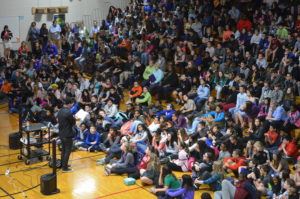
After another standing ovation, they had one more stop before having their first real break of the day. Ten eighth-graders, seated on the ground, on a couch or in comfy chairs, led by their t-shirt-and-jeans English teacher, took turns reading their poems aloud for Nate and Kevin. Their styles of both writing and presentation varied as much as their personalities. The small group from this West County school included Black, White, Southeast Asian, Indian, Latino, and Middle Eastern students. Afterward, I told their teacher that he had done a great job. “I didn’t do anything. They did it all,” he said with an arms-folded shoulder shrug. But that was false. He created a safe place in which young St. Louisans could be utterly honest. But like Coval and Marshall, this teacher knows that when you’re lucky enough to do what you’re called to do, accolades aren’t necessary.
